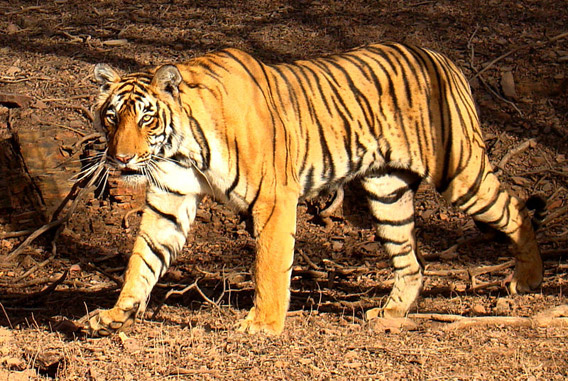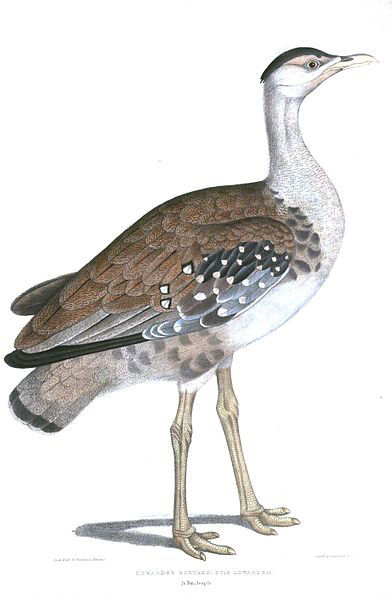
Bengal tiger in Rantgambhore National Park. Photo by: Bjørn Christian Tørrissen.
Nearly half of India’s wildlife budget goes to one species: the tiger, reports a recent article in Live Mint. India has devoted around $63 million to wildlife conservation for 2013-2013, of which Project Tiger receives $31 million. The Bengal tiger (Panthera tigris tigris) is currently listed as Endangered by the IUCN Red List; however India is also home to 132 species currently considered Critically Endangered, the highest rating before extinction.
After tigers, elephants receive the next greatest amount: $4 million or 6 percent of the total. Combating the illegal wildlife trade—one of the gravest threats to many of India’s species—is funded with just $1 million. Many of the nation’s species receive no government funding whatsoever.
“The Great Indian bustard was a priority species for action for which we even developed a species recovery plan (along with the Bengal florican, the lesser florican, Jerdon’s courser, the giant clam, the hangul, the Bastar wild buffalo), but funds were not allocated by the government,” Asad Rahmani, the director of the Bombay Natural History Society told Live Mint.
The Great Indian bustard (Ardeotis nigriceps) is down to only about 250 individuals. The hangul, or Kashmir stag (Cervus elaphus hanglu), has fallen to 160 individuals. After being thought extinct for 80 years, Jerdon’s courser (Rhinoptilus bitorquatus) may be down to just fifty birds.
Worldwide, there are around 3,000 tigers surviving in six distinct subspecies. The Bengal tiger is generally considered to be the most robust. In 2010, all 13 tiger range countries met for a Tiger Summit and pledged millions to protect the world’s largest cat from extinction. Some conservationists argued that protecting flagship species—such as the tiger or elephant—translates into protections for other species in the same habitats. While this is somewhat true, many of India’s imperiled species, for example, are found outside of tiger habitat. In addition, more-and-more threatened species require targeted conservation actions if they are to survive.

Illustration of the Great Indian bustard which stands about one meter (3.3 feet) high. From Thomas Hardwicke’s Illustrations of Indian Zoology.
Related articles
Claim of human and tiger ‘coexistence’ lacks perspective

(01/29/2013) Nepal’s Chitwan National Park was the site of a study, published in September 2012 by Carter and others, which concluded that, tigers coexist with humans at fine spatial scales. This paper has ignited a scientific debate regarding its implications for large carnivore conservation worldwide, with scientists at institutions worldwide questioning the validity of claims of coexistence. At the foundation of this debate, perhaps, is the unresolved question, “what is coexistence?”
Living beside a tiger reserve: scientists study compensation for human-wildlife conflict in India

(01/21/2013) During an average year, 87% of households surrounding Kanha Tiger Reserve in Central India report experiencing some kind of conflict with wild animals, according to a new paper in the open-access journal PLOS One. Co-existence with protected, free-roaming wildlife can be a challenge when living at the edge of a tiger reserve. “Local residents most often directly bear the costs of living alongside wildlife and may have limited ability to cope with losses” wrote the authors of the new paper.
Leopard poaching is a bigger problem in India than previously believed

(10/31/2012) A recent study conducted by wildlife trade monitoring group TRAFFIC uncovered unnerving statistics about the illegal trade of leopards (Panthera pardus) in India: at least four leopards have been poached every week for the past decade in the country. The study, entitled Illuminating the Blind Spot: A study on illegal trade in Leopard parts in India, highlights the severity of leopard poaching from 2001 to 2010, despite preventative measures established in 1972 by the Wildlife Protection Act (WLPA) that prohibit the sale of leopard parts in India.
Appreciating elephant individuality: a new approach to preventing conflicts with humans

(10/09/2012) To prevent conflicts between humans and elephants in developed areas, a new study shows there is much to learn from analyzing Asian elephant behavior at the individual level as opposed to population studies. Researchers have traditionally interpreted elephant behavior at the population level, looking for behavior patterns among elephants of similar ages, group sizes, and genders. Today, field researchers in India are studying elephant behavior at the individual level. Their goal is to appreciate the idiosyncrasies of individual elephants in the hopes of predicting their behavior. Nishant Srinivasaiah, of the Tata Institute of Fundamental Research and lead author of the study, told mongabay.com that it is vital “to get to know our elephants more intimately than ever before and, more importantly, to shift our focus from a population to include its individuals as well.”
Livelihoods depend on the environment in the Western Ghats
(09/27/2012) In the Uttar Kannada district of the Western Ghats, the livelihood of the average individual depends largely on the well being of the environment. Six months ago, before large-scale mangrove planting of the area, if someone were to walk through the banks of the mangroves in the Western Ghats he would see many fishermen casting their long nets and wires, time and time again noticing pieces of trash such as plastic grocery bags tangled in the nets.
Tiny new frog discovered in India bypasses the free-swimming tadpole stage
(09/07/2012) A tiny new frog species has been discovered in the rainforests of India’s Western Ghats.
Recommendations to save India’s Western Ghats creates political stir

(08/20/2012) A massive expert panel report on the conservation of the Western Ghats has caused a political stir in India. The report, headed by noted ecologist Madhav Gadgil, recommends that the government phase out mining projects, cancel damaging hydroelectric projects, and move toward organic agriculture in ecologically-sensitive sections of the Ghats. The report, which was leaked after the government refused to release it, has yet to be implemented. Recently dubbed a UNESCO World Heritage Site, the Western Ghats is one of India’s largest wildernesses and home to thousands of species, many found no-where else.
Tigers vs. coal in India: when big energy meets vanishing cats

(08/01/2012) Burning coal fuels climate change, causes acid rain, and spreads toxic pollutants into the environment, but now a new Greenpeace report warns that coal may also imperil the world’s biggest feline: the tiger. Home to world’s largest population of tigers—in this case the Bengal subspecies (Panthera tigris tigris)—India is also the world’s third largest coal producer. The country’s rapacious pursuit of coal—it has nearly doubled production since 2007—has pushed the industry into tiger territory, threatening to destroy forests and fragment the tiger’s already threatened population.